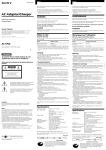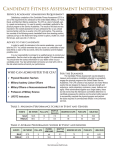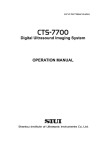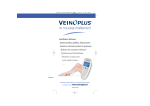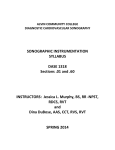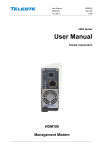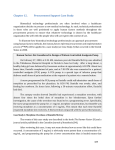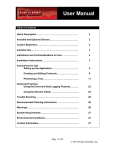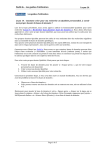Download ACUSON X150™ Knobology & User Guide
Transcript
ACUSON X150™ Knobology & User Guide ACUSON X150™ CONTROL PANEL Table of Contents The ACUSON X150 knobology and user guide is the clinicians quick reference of system terms, functions and capabilities. This guide was created to simplify the information contained within the Siemens ACUSON X150 User Manual. For more detailed information please refer to your Siemens User Manual. For your convenience, the Siemens User Manual pages that correspond to the content in this guide, are reference at the bottom of each page. Chapter 1, Knobology ……………………………………………………...p 1-2 thru 1-18 Chapter 2, System Setup …………………………………………………p 2-1 thru 2-11 Chapter 3, Patient Data ..…………………………………………………..p 3-1 thru 3-5 Chapter 4, Exam Quick Sets ….…………………………………………p 4-1 thru 4-28 Chapter 5, Phlebology Optimization Guide………………………………p 5-1 thru 5-5 Copyright © 2008-2009 United Medical Instruments Inc. Key Board New Patient – activates new patient screen Report – access to calculations report for current patient Patient Data – used to modify patient data Patient Browser – accesses DIMAQ-IP data Exam - activates Exam Presets for active transducer Presets - activates system Presets Help – activates online instructions for use Quick Set – stores a Preset with User preferences as a Quick Sets Tab Key Caps Lock Key Shift Key ACUSON X150 User Manual reference pages 3-6, 3-20 thru 3-26, 5-3 thru 5-10 1-2 Toggle, Row, & Soft Keys ACUSON X150™ system Toggle Keys are used to optimize the ultrasound image and vary with the active Mode or function. Page (Row) Key - Alternates between the top and bottom monitor soft key menu levels. On-Screen Mode Soft Keys 2D Color Doppler PW Doppler M-Mode Text ACUSON X150 User Manual 2.0 reference pages 3-10, 3-12, 3-31 thru 3-35 1-3 Mode Key Functions • • Pushing the knob initiates the desired mode Rotating the knob allows you to adjust the gain for the given mode Doppler (D) - is used to “listen” to blood flow. Vascular Sonographers follow orientation standards when documenting direction of blood flow. Arterial blood flow travels toward the transducer and is represented as flow above the spectral baseline. Venous blood flow travels away from the transducer and is represented as flow below the spectral baseline. The spectral wave form can be measured in either time or amplitude and is used to document the amount of normal versus abnormal flow. Color (C) - is the color representation of the direction of blood flow. Vascular Sonographers document arterial flow, flow towards the transducer, with red color filling and normal venous flow, flow away from the transducer, with blue color filling. Power Doppler (P) - demonstrates the back-scattered power of the Doppler signal allowing the scanner to display the presence of moving blood cells. It does not indicate the relative velocity or direction of flow. B - Mode (2D) - the two-dimensional diagnostic ultrasound representation of echo-producing interfaces in a single plane. This is a multi - function knob. Turn the knob to adjust the image’s overall gain. Push the knob to exit out of Doppler and/or color Doppler. M - Mode (M) - (motion mode) a type of B-mode ultrasonography in which spots on the CRT display produce a tracing of the motion of echogenic objects. Used in echocardiography. Tissue Harmonic Imaging (THI) - improves the contrast and spatial resolution to help eliminate low level echoes in the 2D image. ACUSON X150 User Manual 2.0 reference pages 3-11 thru to 3-15 1-4 User Keys & Home Base User Keys Steer/Angle knob Controls: 2D Imaging -Will steer the 2D image on the VF10-5 and Vf13-5 transducers. Color Doppler - Will steer the color Doppler ROI on linear transducers. PW Doppler - Rotates the steer cursor. - Press knob to activate the angle correction indicator. - Rotate to adjust the angle correction between 45 - 60 Home Base User Keys Trackball - Is used to control the system cine loop, color Doppler box size and curser. Update Key – Is used to move between different functions (i.e. pw strip and image or measurement calipers). Set Key - Is used to set a function (i.e. Calipers, Cine edits, color box size). Example: Push down on the C knob to initiate color Doppler. The color box lines appear solid green. Press the set key; the box lines become dotted. Use the track ball to increase or decrease the vertical or horizontal size of the color Doppler box, then press set again to lock the box in the desired size. Escape Key - Exits the currently displayed mode, function, or page and reactivates the previous mode, function, or page. Pressing the Escape/Priority key changes which tool is currently under the control of the trackball. Caliper Key - Initiates the measurement package for the selected exam. Press the Caliper Key a second time to obtain the 2nd curser. Press the Set key to lock the measurement. Press the Escape key to exit the measurement function. ACUSON X150 User Manual 2.0 reference pages 3-6, 3-8 thru 3-9, 3-14 1-5 Control Panel Dual/Select • Pressing the left Dual/Select button will freeze the object of interest in an image screen on the left side of the monitor. Pressing the right Dual/Select button will freeze the second object of interest in the image screen on the right side of the monitor. Transducer • Allows the user to alternate between 2 active transducers. Text Annotation on screen • • • Is an archive text function. Press to initiate the on screen soft key menu. Work flow features: 1. Position the curser next to the anatomical phrase to highlight it. 2. Use the trackball to drag the phrase to the desired location on the image. 3. Press the set key to lock the position of the phrase on the image. Library On - Activates the on-screen annotation library. Arrow - Activates the on screen arrow. Use the trackball and “Set” to position the arrow. Delete Word - Will delete the word indicated (green text) by the text cursor. Home - Will send the cursor to a pre-determined home position. Hide Text – Temporarily hides all the text on the screen. Home Set - Allows the user to indicate the “Home” position for the text cursor. Clear Screen - Removes all annotations from the screen, including arrows and pictograms. ACUSON X150 User Manual 2.0 reference pages 3-12, 3-16, 3-18, 3-40 1-6 Control Panel Pictogram Screen Menu • • • Pictograms are based on the performed exam. Use the toggle key to select the desired pictogram. Use the Select know to rotate the direction of the curser to illustrate the image view as transverse or longitudinal. Select Knob Is a dual-function control that activates one function when the control is pressed and another function when the control is rotated. • Used to select functions in the control menu. • Control menu selections vary with active mode. Example: In Triplex Mode (color Doppler, pulse wave Doppler, and 2D imaging) turn the knob to highlight 2D mode, push the knob until it reads P mode. Next, turn the knob to highlight “Sweep”. Push the knob to change the sweep speed of the spectral Doppler trace from 2 to 4. Select Knob on Screen Mode Menus ACUSON X150 User Manual 2.0 reference pages 3-7, 3-18, 3-27 thru 3-30, 3-41 1-7 On Screen Mode Menus 2D Mode Menu Transmit Power - Adjusts the amount of energy transmitted (100% - 0.20%). U/D Flip - Flips the apex of the image up or down (used mainly for prostate biopsy). L/R Flip - Flips the image Left or Right. Sector - Activates virtual format on VF10-5 transducer. Split - Live Dual image allows you to have a 2D image and a image with color Doppler active in separate screens. 4B - Provides separate 2D images on one screen. Ideal for AFI measurements. 3D - Allows acquisition of three-dimensional ultrasound images. C - Mode Menu Transmit Power - Adjusts the amount of energy transmitted (100% - 0.20%). Display - Turns the color display on or off. Invert - Changes the “direction” of the color map so flow towards the transducer is displayed with the opposite color. VelTag - Tags specific blood flow velocities or a range of velocities in real-time, Cine or on a frozen image. Peak - Period of time that peak color velocities are collected. 4B - 4B images can also be collected in Color and Power. P - Mode Menu Transmit Power - Adjusts the amount of energy transmitted (100% - 0.20%). Display - Turns the color display on or off. Background - Background writes over all B-Mode information within the ROI. 4B - 4B images can also be collected in Color and Power. ACUSON X150 User Manual 2.0 reference pages 3-28, 3-30 1-9 On Screen Mode Menus D - Mode Menu Transmit Power - Adjusts the amount of energy transmitted (100% - 0.20%). T/F Res - Adjusts Time/Frequency resolution for finer detail of either the time or frequency data. Sweep - Adjust the scrolling speed of the Doppler Spectrum. Invert - Inverts the spectral Doppler display above or below the baseline. Tint - Changes the colorization of the displayed signal. Tint 2 - Grey Tint 5 - Slate/Cool Blue Tint 9 - Magenta/Sepia Tint 10 - Aqua Tint 11 - Magenta Tint 13 - Wheat Tint 15 - Sepia Full D - Activates a full-screen format for the Doppler spectrum. Trace - Provides a mean and maximum velocity trace of PW waveforms. Triplex - Allows mixed mode imaging to display simultaneously in real time. The update key will toggle triplex off. M - Mode Menu Transmit Power - Adjusts the amount of energy transmitted (100% - 0.20%). Full M - Displays a full screen M sweep. ACUSON X150 User Manual 2.0 reference pages 3-28 thru 3-29 1-8 Control Panel Depth/Zoom • • • Rotate to increase or decrease depth of field. Push to initiate zoom and rotate to zoom in or out. Use the track ball to “pan” move the object of interest to center of zoom field. Focus • Rotate to adjust the position of the focal zone. Press knob to increase the number of focal zones (up to 4 focal zones available). • Two customizable keys for printing and storage of images. Chose between: • • • • B/W Print Color Print Disk Store DICOM B/W Print • • • DICOM Color Print Disk Store & B/W Print Disk Store & Color Print Freeze Freezes the image, sweep or spectrum on the screen. If an image or sweep is already frozen, pressing the FREEZE key restores real-time imaging. Time Gain Control (TGC) Is a filter that allows the user to remove electronic noise as well as extraneous high and low level echoes from an image. ACUSON X150 User Manual 2.0 reference pages 3-8, 3-16 thru 3-17, 3-19 1-10 2D Toggle Keys MultiHertz - Allows you to toggle through the three available transducer frequencies. Dynamic Range (DR) - Controls the overall contrast resolution of the image. DR adds more shades of grey for a smoother image. DR removes shades of grey for a more contrasting image. Persist - Frame averaging function that determines the amount of image motion smoothing. Minimum Value: 0 - removes history, increasing the frame rate to create a sharper image. Maximum Value: 4 - adds history to the image, slowing the frame rate to create a smoother image. Edge Enhance - Controls the sharpness of edges. Minimum Value: 0 (Soft) Maximum Value: 3 (Sharp) Map - Select the grayscale map of your liking with 9 maps available (A thru I). Map A (more shades of grey) Map I (fewer shades of grey) Tint - Colorizes the grayscale image R/S - Controls the image resolution versus frame rate. Minimum Value: 0 (Soft) Maximum Value: 5 (Sharp) ACUSON X150 User Manual 2.0 reference pages 3-11 1-11 2D Toggle Keys Measurement & Calculations Soft Keys Distance - Is a simple linear measurement between two points. Area - Calculates the area using the Ellipse or Trace method. Ellipse - The system determines one diameter using the end points of the ellipse and calculates the second diameter. Trace - The system determines the circumference and area using the hands free trace method segments. Angle - Determines the Angle using two (connecting or intersecting) lines that you place on the image. % Stenosis - Calculates the percentage of stenosis based on the area or diameter of the same vessel. A-% Stenosis - Calculates the area % stenosis, comparing the cross-sectional areas of the same vessel. D-% Stenosis - Calculates the diameter % stenosis, comparing diameters of the same vessel. Volume - Performs a volume measurement with either a distance measurement, ellipse measurement or Trace measurement. Flow Volume - Measures the distance or area to calculate the blood flow volume. A-Flow Volume - Is the estimation of blood flow based on the area of the vessel. D-Flow Volume - Is the estimation of blood flow volume based on the diameter of the vessel. ACUSON X150 User Manual 2.0 reference pages 3-38 1-12 Color Toggle Keys TxFreq - Allows you to toggle through the two available color frequencies. PRF - Controls the velocity range in color Doppler. PRF until there is wall to wall color filling without color aliasing for vessels with faster blood flow, arteries. PRF until there is wall to wall color filling without overfilling the vessels with slower blood flow, veins. Persist - Averages color frames to improve sensitivity and reduce clutter. Minimum Value 0: (Color corresponding to blood flow is replaced by another, faster rate) Maximum Value 4: (Color corresponding to blood flow is replaced by another, slower rate) Filter - Changes the transition point of the clutter filter to enhance low flow versus eliminating clutter artifacts. R/S - Adjust the balance between the image line density (resolution) and the frame rate. The line density increases resolution and decreases frame rate creating a more compressed image. Map- Displays measured velocity and/or variances as shades of color. Priority - Changes the priority of color and B-mode data. Smooth - Changes the amount of spatial smoothing in the image. Minimum Value: 0 (Decreased motion smoothing) Maximum Value: 4 (Increased motion smoothing) Baseline - Adjusts the relative baseline position up and down. A shift in baseline adjusts the range of displayed flow velocities without changing the system PRF. Flow - Optimizes hemodynamic flow conditions by automatically adjusting the wall filter and PRF parameters for the selected Flow state. Low - Maximum sensitivity to low velocity flows. Medium - Balances between suppression and sensitivity of velocity flow. High - Optimized for the high arterial flow common to pulsatile vessels and stenotic conditions. ACUSON X150 User Manual 2.0 reference pages 3-34 1-13 Doppler Toggle Keys MultiHertz - Allows you to toggle through the three available transducer frequencies. PRF - Controls the velocity range in pulse wave Doppler. PRF to sample increased vessel blood flow, arteries or if the wave form wraps around the baseline . PRF to sample slower vessel blood flow, veins or to increase the size of the wave form on the baseline. Baseline - Adjusts the relative baseline position up and down. A shift in baseline adjusts the range of displayed flow velocities without changing the system PRF. Gate - Adjust the size of the pulse wave gate. Gate should fit within the lumen of the sampled vessel. The gate should not touch the vessel walls. Volume - Adjust the spectral wave volume. Map - Displays measured velocity and/or variances. Map A - Map H DR - Dynamic Range controls the overall contrast resolution of the spectral wave form. DR adds more shades of grey DR removes shades of grey (more contrast) Invert - Inverts the spectral wave form to or away from the transducer. Ang 60/0/60 - Shortcut between 60 degrees angle correction and 0 degrees angle correction. Update Rate - Adjust the amount of time for the spectrum update. Ranges: Off, 2 sec, 4 sec, 8 sec ACUSON X150 User Manual 2.0 reference pages 3-33 1-14 Doppler Toggle Keys Measurement & Calculations Soft Keys Velocity - Is the Distance over time measurement determined by a measurement marker placed along a vertical plane. PI Auto - Use an automatic trace of the spectrum to determine a pulsatility index. Acceleration - Acceleration or Deceleration of speed over the time traveled determined by two measurement markers. Velocity Ratio - Calculate a ratio of two velocity measurements. HR - Heart rate determined over one heart cycle. RI - Pourcelot's Ratio: RI = [PS-ED] / [PS] (4) PI Manual - Use a manual trace of the spectrum to determine a pulsatility index Flow Volume - Selects methods for estimating blood flow volume. Time - Interval in milliseconds between two measurement markers. ACUSON X150 User Manual 2.0 reference pages 3-39 1-15 M-Mode Toggle Keys M-Mode Toggle Keys MultiHertz - Allows you to toggle through the three available transducer frequencies. DR - Dynamic Range controls the overall contrast resolution of the M-Mode sweep. Tint - Colorizes the M-mode sweep. Edge Enhance - Distinguishes the contours of a structure during real-time imaging. Sweep - Adjust the scrolling speed of the M-mode sweep. Map - Selects a processing curve that assigns echo amplitudes to gray levels. Measurement & Calculations Soft Keys Distance - Is the vertical distance between two points in the M-mode sweep. HR - Is determined over one heart cycle in 2D/M-mode. Slope - Distance over time calculation determined by two distance measurement markers. Time - Is the interval in seconds between two measurement markers. ACUSON X150 User Manual 2.0 reference pages 3-32 and 3-39 1-16 Power Toggle Keys TxFreq - Allows you to toggle through the two available color frequencies. PRF - Controls the scale factor assigned to slow flow. PRF to sample increased vessel blood flow, arteries or if the wave form wraps around the baseline . PRF to sample slower vessel blood flow, veins or to increase the size of the wave form on the baseline. Persist - Adjusts the time over which power data are processed in calculating the power amplitude display. Filter - Balances the low flow sensitivity with flash suppression. R/S - Adjust the balance between the image line density (resolution) and the frame rate. The line density increases resolution and decreases frame rate. Map - Selects a processing curve that assigns flow amplitudes to color levels. Priority - Adjusts the threshold for the amplitude of the Power display. Smooth - Adjusts the level of spatial averaging used to smooth the display of the flow pattern. Flow - Optimizes hemodynamic flow conditions by automatically adjusting the wall filter and PRF parameters for the selected Flow state. Low - Maximum sensitivity to low velocity flows. Medium - Balances between suppression and sensitivity of velocity flow. High - Optimized for the high arterial flow common to pulsatile vessels and stenotic conditions. ACUSON X150 User Manual 2.0 reference pages 3-35 1-17 Cine Toggle Keys Frame Recall - Allows you to retrieve individual frames of the CINE loop. Edit Start - Defines the beginning point of the CINE loop. Edit End - Defines the ending point of the CINE loop. Edit Reset - Allows you to reset the beginning and ending points of the CINE loop. ACUSON X150 User Manual 2.0 reference pages 3-32 and 3-36 1-18 Setting Up Your System Press the Preset Menu setting up your system. button located on the top row of the key board to begin . Basic System 1 Menu Enter the hospital name, establish date/time settings and format, designate height and weight formats, and select the system monitor, audio, and boot-up settings. 1. The Date & Time Settings button is only active if you are not currently in a patient study. Use the Date Format drop down menu to select: Month/Day/Year, Day/Month/Year or Year/Month/Day. 2. To disable the Screen Saver, uncheck the Enable Screen Saver box. 3. Sliding the Beep Volume curser allows you to adjust the volume of the Beep associated with pressing all onboard mode and user keys. ACUSON X150 User Manual 2.0 reference pages 3-3 thru 3-7 2-1 Setting Up Your System Basic System 2 Menu Allows the User to specify DGC settings, select the trackball speed, define information stored within images, enable patient demographic display and storage, and select the library of annotations for initial display. 1. Click to activate the DGC Invert with Image Invert box if to invert the DGC with endovaginal and endorectal exams. 2. Check CW (Clockwise) or CCW (Counter Clockwise) to indicate how the image Depth/ Zoom, Steer and Focus react. 3. The Trackball behavior can be set as Slow, Medium, or Fast. 4. Patient ID - Check the Auto Store New Patient form box. 5. Annotation Type - Set the default type to Anatomy. ACUSON X150 User Manual 2.0 reference pages 3-5, 3-8 thru 3-9 2-2 Setting Up Your System Peripheral Menu Assign functionality to documentation controls, the optional footswitch, and ports on the input/output panel of the ultrasound system. 1. Print Key Destination is a customizable key and can be set to B/W Print, Color Print, USB Print, Cine Print, Disk Store, Volume Store, DICOM B/W Print, DICOM Color Print, Disk Store & B/W Print, or Disk Store & Color Print or Disk Store & USB Print. 2. Print/Store Key Destination is a customizable key and can be set to B/W Print, Color Print, USB Print, Cine Print, Disk Store, Volume Store, DICOM B/W Print, DICOM Color Print, Disk Store & B/W Print, or Disk Store & Color Print or Disk Store & USB Print. 3. Foot Switch - User can control the image by setting the left and right foot switch pedal preference to Freeze, B/W Print, Color Print or Disk Store. ACUSON X150 User Manual 2.0 reference pages 3-5, 3-10 thru 3-11 2-3 Setting Up Your System Display Menu Specify the automatic responses when the system is frozen or unfrozen and establish Doppler and M-mode imaging settings. Common Mode settings allows the user to customize the display features of their system. 1. Uncheck the Delete Text on Unfreeze to prevent having to retype/enter annotations. 2. Check Default Annotation Library On box to activate the library when pressing the annotation button. 3. Other customizable features include: (Font Size, Arrow Size, Patient Registration type, or Measurement Result Display Size). Doppler/M-Mode 1. Select the system response when the M or D control is pressed. Check the box to immediately display M-mode or Doppler. Un-check the box to initially display an M-mode or Doppler cursor in the 2D-mode image; the M or D control must then be pressed a second time for M-mode or Doppler to display. 2. Doppler Frequency/Velocity - User can select the method to display the pulse wave Doppler measurements. 3. Measurement Result Display - User can designate the location on the monitor to display the pulse wave Doppler measurement. ACUSON X150 User Manual 2.0 reference pages 3-5, 3-12 thru 3-13 2-4 Setting Up Your System Exam Configuration Menu Modify general settings for the selected exam type. 1. Exam - Identifies the system exam preset or quickset the user is in. 2. Automatic Freeze Response is a customizable key the user can select the CINE, Caliper, Text, Arrow, Pictogram functions that will activate upon freezing the image. 3. Seamless Dual - removes a 1mm space that separates the Dual Image screens 4. Steer Angle Type - Specify the steering angle for the VF10-5 transducer. 5. 2D/M & 2D/Doppler Display Format is a customizable key the user can select how the 2D image and the pulse wave or m-mode Doppler are represented on the monitor. 6. Default Doppler Update Style is a customizable key the user should select 2D-Lv/D-Lv to allow the system to automatically activate triplex mode when color Doppler and pulse wave Doppler are both activated during an exam. ACUSON X150 User Manual 2.0 reference pages 3-5, 3-14 thru 3-15 2-5 Setting Up Your System Text Annotation Menu Customize annotation libraries for selected Exam types or Quicksets. 1. Exam & Quickset - Identifies the name of the preset exam the system is in or the exam the quickset was created from. 2. Text Annotation - Edit, modify, or replace factory preset annotations Modify - Highlighted text will appear in the text annotation box. Make your changes then click on modify to save your changes. Add - Enter the term/phrase you desire into the box and click on add. Delete - Highlight term to delete then click on delete Move - Highlight term to move up or down and then click on the appropriate key. ACUSON X150 User Manual 2.0 reference pages 3-5, 3-16 thru 3-18 2-6 Setting Up Your System Pictogram List Menu Customize pictogram libraries for selected Exam types or Quicksets. 1. Exam & Quickset - Displays the system factory preset or quick set name of the current exam. 2. All Pictograms - Displays all the possible pictograms for every exam available on the system. 3. Add - Highlight the desired pictogram you want to have available in the “Selected” menu box. for the exam listed above. Click on the add button to move the pictogram to the “Selected” menu box. 4. Delete - Select the desired pictogram you want to remove from the “Selected” menu box. Click on the delete button to remove it. 5. Move - Highlight the pictogram and click on up or down to arrange the pictograms in the “Selected” menu box. ACUSON X150 User Manual 2.0 reference pages 3-5, 3-19 thru 3-21 2-7 Setting Up Your System General Caliper (changes general settings that apply to all exam types) 1. Caliper Default Position - can be set to appear at the top of the image, the bottom of the image or in the center of the image. 2. Caliper Size - can be set as small, medium or large. 3. Caliper pattern - can be designated as a x or + for the entire system. Multiple measurements use the same shape and are differentiated by number. 4. Measurement Results Background - is a shaded box that you can turn on or off. Measurement and Report Preset Menu 1. Measurement Method is used to establish a shortcut to a specific measurement method. 2. Item & Reference Selection is unique to Standard and Early OB exam measurement calculations. 3. Comments Library for Report a. For use with OB, Early OB, GYN, Urology, Cardiac, Orthopedic, P-Vascular, C-Vascular, Venous, Fetal Echo, Pediatric Echo, Penile, TCD, EM exam types b. User can enter ten comments for exam types with reports. ACUSON X150 User Manual 2.0 reference pages 3-5, 3-22 thru 3-29, 3-36 2-8 Setting Up Your System Common Preset for OB & Early OB 1. Display Item selection is used to control display of various items on the measurement screen and in the patient report. The Display Item screen is unique for each exam type. 2. User-Defined Label selection is used to designate special measurement labels. 3. User-Defined EFW/MA Data tab is used to select preferred authors for two EFW formulas. Both formulas display in the worksheet and the report. The EFW1 formula displays in the Measured Results when the required measurements have been made. You can also select an average USMA to be returned as measurements are made or specify that one of Hadlock's eleven regression equations be used. 4. Growth Analysis Graphs selection is used to set up growth curves for OB and Early OB exams. ACUSON X150 User Manual 2.0 reference pages 3-5, 3-35 thru 3-47 2-9 Setting Up Your System Measurement & Report Menu 1 Use this selection to establish a shortcut to a specific measurement method. The upper section of this screen allows you to select the method activated when the system first enters the measurement function for the specified imaging mode. The lower section of this screen allows you to select a specific method for automatic activation when a general measurement method is selected in the measurement function. For example, if Ellipse is selected in the Area field, selecting Area from the list of general measurement methods automatically activates the Ellipse method. Measurement & Report Menu 2 The Measurement & Report 2 item on the Preset screen provides the following selections: Heart Rate Tool allows the user to determine the number of heart cycles (1, 2, 3, 4, 5) used to calculate a Heart Rate. ACUSON X150 User Manual 2.0 reference pages 3-24, 3-30 2-10 Begin a patient exam by press the New Patient The Patient Data key exam. key. is used to modify the patient information for the currently active Example: You enter Betty Lyn Smith born on March 2, 1947 into the system. You bring your patient into the exam room and verify their personal information and discover Betty Lynn Smith was actually born on March 22, 1947. You will be able to correct her date of birth in the patient data form by pressing the Patient Data Key, not the New Patient key. Once you have made your corrections the system will archive the patient data form. The system stores the patient data to the system's hard disk when you select the OK button at the bottom of the New Patient Data form. ACUSON X150 User Manual 2.0 reference pages 4-1 2 DIMAQ-IP Screen DIMAQ-IP Screen The DIMAQ-IP feature is an integrated workstation with comprehensive on-board image and data management capabilities. 1. The image screen (DIMAQ-IP screen) displays the images for the currently selected study. 2. The study screen lists the studies that are saved on the selected disk (HD or CD/DVD). 3. Screens are accessed by pressing the Patient Browser key on the keyboard. 4. To display the Image screen (from the Study screen), select the Image Screen button on the left of the screen. 5. To display the Study screen (from the Image screen), select the Study Screen button on the left of the screen. ACUSON X150 User Manual 2.0 reference pages 4-4 3 DIMAQ-IP Screen functions 1. 2. 3. 4. 5. 6. 7. 8. 9. Sort - by patient name, patient ID, date/time, images, archived, Mbytes. Search - for a patient by their last name or ID, or enter the study date or date range. Hide studies. Delete - images and reports from studies that are stored on the system’s HD. Edit - can make measurements on images from the current examination. You can also store or print the image with the measurements. Transfer - studies that are located on the system’s HD or inserted CD/DVD. Delete - studies from the system’s HD. Manage - system notifies you when the HD is nearly full indicating that un-archived studies will be immediately deleted. Files saved to CD’s/DVD’s are labeled by the related patient ID. Study folders are labeled with the date and time of the study. ACUSON X150 User Manual 2.0 reference pages 4-5 thru 4-24 4 External Storage of Patient Exams Backing up the system hard drive is user/clinic dependant. The easiest way is to back up a batch of patient exams at the end of the day, at one time. Insert a new CD into the CD tray. 1. Use the trackball to move the cursor over the first patient exam to be exported. 2. Press the set key to highlight the patient’s information “blue” as done below. 3. Next, move the cursor to the last name that you want to export and let it hover over it. The text of the patient information will change from black to blue. 4. Leave the cursor hovering over the last name. Next, press the Shift and Set keys at the same time. This will select all the patient exams from the 1st one highlighted to the last one selected. 5. Un-check the DICOM button located in the CD information box. (If left checked, a free DICOM viewer will be downloaded to your computer when images are reviewed. All images are in a read-only format. 6. Leave the Tiff box checked. 7. Click on the export button. Under the export button you will see a blue time line tick off. Near the end of the export, you will see/hear the CD tray open and then close. 8. You have exported all patient exams to the CD. 5 Reviewing your patient exams on your PC 1. Insert the system back up CD into the CD tray of your computer. 2. A window will open with a folder labeled Siemens, double click on the folder. 3. Another window will open with two folders located inside. One labeled studies, the other labeled system. 4. Double click on the studies folder. You will then see multiple folders that are labeled by exam dates. 5. Open the first folder by double clicking on it and again on the folder inside. 6. You now have a window with folders labeled clips, exports, images and reports, as well as two adobe PDF files. 7. Double click on the images folder. You can now select the image in a slide show or copy and paste them to a specified folder on your desk top. 6 Ultrasound Exam Quick Sets System Exam Quick Set Generally, the factory exam presets are sufficient for your clinical day to day scanning needs. However, you can customized the factory preset and save a new setting as a quick set that will be available in your exam menu. This section will walk you through step by step instructions on creating Phlebology, Obstetrics, Vascular, Cerebrovascular, Abdomen, Urology, and MSK Exam quick sets. Recommended settings listed within this guide were obtained from end users as well as system application specialist. 1. Phlebology ……………………………………………………………...p 4 -1 thru 4 - 7 2. Obstetrics ………………………………………………………………p 4-8 thru 4-13 3. Vascular ………………………………………………………………p 4-14 thru 4-19 4. Cerebrovascular ………………………………………………………p 4-14 thru 4-19 5. Abdomen ………………………………………………………………p 4-20 thru 4-25 6. Urology ………………………………………………………………...p 4-20 thru 4-25 7. Musculoskeletal ……………………………………………………….p 4-26 thru 4-29 8. Podiatry …………………………………………………………………p 4-30 thru 4-33 Phlebology Exam Quick Set Start a new patient exam in the Thyroid or MSK setting of your linear transducer. Use the toggle keys and their corresponding soft keys on your monitor to adjust the 2D, color Doppler, and pulse wave Doppler menus of your system. You can track soft key adjustments on the system display menu (enclosed in blue box). 2D Image Parameters dB - set to 49 (turn 2D knob) MultiHertz - should be set to 10.0 MHz for the VF10-5 transducer and 11.4 MHz for the VF13-5 transducer Dynamic Range (DR) - decrease to 50 dB Persist - set to number 3 Edge - set to number 2 R/S - set to number 1 Map - set to F (H or I for more contrast D for less) Tint - set to number 1 2D Image Overall Gain Adjustment Turn the 2D knob to adjust the amount of overall gain of the image. 4-1 Phlebology Exam Quick Set 2D Image Depth Adjustment Adjust the depth of the image to 3 cm by turning the Depth/Zoom knob. 2D Image Focus Adjustment Then, push the Focus knob to add a focal zone in the imaging field. This will leave 2 focal zones on the image. Color Doppler Box Adjustments Adjusting the size of the color Doppler box 1. Push the color Doppler knob to initiate that modality. 2. The color Doppler box will appear on the screen as a solid lined item. 3. Push the Set key (to the upper right of the tract ball) to change the box from a solid line to a dotted line. 4. Use the tract ball to adjust the height and width of the box until you have it set to a familiar size. 5. Press the Set Key again to lock the box size. 4-2 Phlebology Exam Quick Set Color Doppler Adjustments, Cont. PRF - should be set to 1022 Hz Persist - set to number 3 Filter - set to number 1 R/S - set to 2 Map - set to A Priority - set to 4 Smooth - set to number 2 Flow - set to M Pulse Wave Doppler Adjustments PRF - should be set to 977 Hz Dynamic Range (DR) - decrease to 55dB Map - set to D Angle Correction - set between 45 - 60 Gate - set to 1.0mm 4-3 Phlebology Exam Quick Set Next, Pulse Wave Doppler Adjustments Steer/Angle - set the PW curser at the angle with the proper angle correction angled from the top left of the image to the bottom right of the imaged for longitudinal evaluations and vertical without angle correction for transverse evaluations. Adjusting the Sweep Speed 1. Push down on the Select know. 2. Turn the knob to highlight “sweep speed” and push the select knob to initiate. 3. Set the Doppler speed to 2. 4-4 Phlebology Exam Quick Set Preset Menu Next, press the Preset button located on the top row of the key board and select the Peripheral Menu. Move the curser to the drop down menu and choose your desired function for the “Print Key” and the “Print/Store Key”. Since most images will be sent to the system hard drive set the Print key to Disk Store and the Print/Store Key to Disk Store & B/W Print. 4-5 Phlebology Exam Quick Set Saving your Quick Set Having completed the previous steps. Press the Quick Set button located on the top row of the key board. The below screen will appear. You can name your exam anything you like. In our example the VEINS is used. 1. Type the name VEINS into the Quickset Name box. 2. Check “Active Quickset when transducer is selected” box. 3. Save the Setting. 4-6 Phlebology Exam Quick Set Next, press the Preset Key again and select Text Annotation in the left navigation menu. 1. Click to highlight the term RT Thyroid. Press the Delete button until all text (except last one) have been deleted. 2. Type RT CFV into the Text Annotation box then press Add (at this point the system will let you delete the last annotation from the previous Thyroid exam “Thyroid”). 3. Continue adding the following phrases; RT FV, RT POP V, RT SFJ, RT GSV P, RT GSV M, RT GSV D, RT GSV KNEE, RT GSV CALF, RT SPJ, RT SSV P, RT SSV M. 4. Add the same annotations for the left. The more specific you are when entering the terms you use the less you will have to add to your image labeling later. Finally, press the quick set button again. 1. Re-enter the same name you previously saved your setting with (VEINS) into the Quickset Name box. 2. Click on the save button. 3. Answer YES to override the previous quick set in the pop up screen. CONGRATULATIONS! YOU JUST CREATED YOUR FIRST CUSTOMIZED SYSTEM EXAM SETTING. 4-7 OB & Early OB Quick Set Start a new patient exam in the OB factory setting with the CH5-2 transducer. Use the toggle keys and their corresponding soft keys on your monitor to adjust the 2D and color Doppler menus of your system. You can track soft key adjustments on the system display menu (enclosed in blue box). 2D Parameter Adjustments THI—30 dB MultiHertz - adjust for better image resolution Dynamic Range (DR) - decrease to 60 dB Persist - set to number 3 Edge - set to number 1 R/S - set to number 3 Map - set to G Tint - set to number 1 or 2 2D Image Overall Gain Adjustment Turn the 2D knob to adjust the amount of overall gain of the image. Initiate THI. 4-8 OB & Early OB Quick Set 2D Image Depth Adjustment Adjust the depth of the image to 15 cm by turning the Depth/Zoom knob. 2D Image Focus Adjustment Then, push the Focus knob to add a focal zone in the imaging field. This will leave 2 focal zones on the image. Color Doppler Box Adjustments Adjusting the size of the color Doppler box 1. Push the color Doppler knob to initiate that modality. 2. The color Doppler box will appear on the screen as a solid lined item. 3. Push the Set key (to the upper right of the tract ball) to change the box from a solid line to a dotted line. 4. Use the tract ball to adjust the height and width of the box until you have it set to a familiar size. 5. Press the Set Key again to lock the box size. 4-9 OB & Early OB Quick Set Next, Color Doppler Adjustments PRF - decrease by 1 toggle (2248 Hz) Persist - set to number 3 Filter - set to number 2 R/S - set to 2 or 3 Map - set to A Priority - set to 4 Smooth - set to number 2 or 3 Preset Menu Next, press the Preset button located on the top row of the key board and select the Exam Configuration Menu. 4-10 OB & Early OB Quick Set Move the curser to the drop down menu and select side by side for the desired action for 2D/M & 2D/ Doppler Display Format. Your 2D image and M-Mode evaluation of the fetal heart will appear on the monitor like the example to the right. 4-11 OB & Early OB Quick Set Next, enter Measurement & Report 1 Move the CRL and the GS calculations from the Selectable Label (left) menu to the active calculations menu (right). Next, use the drop down menu to select Hadlock as the author of the CRL measurement calculation and Tokyo as the author of the GS measurement calculation. 4-12 OB & Early OB Quick Set Saving your Quick Set Hav- ing completed the previous steps. Press the Quick Set button located on the top row of the key board. The below screen will appear. You can name your exam anything you like. In our example OB is used. 1. Type the name OB into the Quickset Name box. 2. Check “Active Quickset when transducer is selected” box. 3. Save the Setting. 4-13 Arterial & Cerebrovascular Exam Quick Set Start a new patient exam in the C-Vascular or P-Vascular factory setting with the linear transducer. Use the toggle keys and their corresponding soft keys on your monitor to adjust the 2D, color Doppler, and pulse wave Doppler menus of your system. You can track soft key adjustments on the system display menu (enclosed in blue box). 2D Adjustments MultiHertz - should be set to 10.0 MHz for the VF10-5 transducer and 11.4 MHz for the VF13-5 transducer Dynamic Range (DR) - decrease to 50 dB Persist - set to number 3 Edge - set to number 2 R/S - set to number 2 Map - set to E (H or I for more contrast) Tint - set to number 1 2D Image Overall Gain Adjustment Turn the 2D knob to adjust the amount of overall gain of the image. Initiate THI. 4-14 Arterial & Cerebrovascular Exam Quick Set 2D Image Depth Adjustment Adjust the depth of the image to 3 - 4 cm by turning the Depth/Zoom knob. 2D Image Focus Adjustment Then, push the Focus knob to add a focal zone in the imaging field. This will leave 2 focal zones on the image. Color Doppler Box Adjustments Adjusting the size of the color Doppler box 1. Push the color Doppler knob to initiate that modality. 2. The color Doppler box will appear on the screen as a solid lined item. 3. Push the Set key (to the upper right of the tract ball) to change the box from a solid line to a dotted line. 4. Use the tract ball to adjust the height and width of the box until you have it set to a familiar size. 5. Press the Set Key again to lock the box size. 4-15 Arterial & Cerebrovascular Exam Quick Set Next, Color Doppler Adjustments PRF - should be set to 4340 Hz Persist - set to number 2-3 Filter - set to number 2 R/S - set to 3 Map - set to A Priority - set to 4 Smooth - set to number 2-3 Pulse Wave Doppler Adjustments PRF - should be set to 3906 Hz Filter - 167 Hz Dynamic Range (DR) - decrease to 55dB Map - set to D Angle Correction - set between 45 - 60 Gate - set to 2.0mm 4-16 Arterial & Cerebrovascular Exam Quick Set Next, Pulse Wave Doppler Adjustments Steer/Angle - set the PW curser at the angle with the proper angle correction angled from the top left of the image to the bottom right of the imaged for longitudinal evaluations and vertical without angle correction for transverse evaluations. Adjusting the Sweep Speed 1. Push down on the Select know. 2. Turn the knob to highlight “sweep speed” and push the select knob to initiate. 3. Set the Doppler speed to 2. 4-17 Arterial & Cerebrovascular Exam Quick Set Preset Menu Next, press the Preset button located on the top row of the key board and select the Peripheral Menu. Move the curser to the drop down menu and choose your desired function for the “Print Key” and the “Print/Store Key”. 4-18 Arterial & Cerebrovascular Exam Quick Set Saving your Quick Set Having completed the previous steps. Press the Quick Set button located on the top row of the key board. The below screen will appear. You can name your exam anything you like. In our example the Arterial is used. 1. Type the name Arterial into the Quickset Name box. 2. Check “Active Quickset when transducer is selected” box 3. Save the Setting. 4-19 Abdomen & Urology Exam Quick Set Start a new patient exam in the Abdomen setting of your CH5-2 transducer. Use the toggle keys and their corresponding soft keys on your monitor to adjust the 2D, color Doppler, and pulse wave Doppler menus of your system. You can track soft key adjustments on the system display menu (enclosed in blue box). 2D Image Parameters MultiHertz - should be set to 10.0 MHz for the Dynamic Range (DR) - Set at 60-70 dB Persist - set to number 3 Edge - set to number 1 R/S - set to number 2 or 3 Map - set to D Tint - set to number 1 or 2 2D Image Overall Gain Adjustment Turn the 2D knob to adjust the amount of overall gain of the image. Initiate THI. Use toggles to set THI at 1.8 or Fundamental 5MHz. 4-20 Abdomen Exam Quick Set 2D Image Depth Adjustment Adjust the depth of the image to 12 cm by turning the Depth/Zoom knob. 2D Image Focus Adjustment Then, push the Focus knob to add a focal zone in the imaging field. This will leave 2 focal zones on the image. Color Doppler Box Adjustments Adjusting the size of the color Doppler box 1. Push the color Doppler knob to initiate that modality. 2. The color Doppler box will appear on the screen as a solid lined item. 3. Push the Set key (to the upper right of the tract ball) to change the box from a solid line to a dotted line. 4. Use the tract ball to adjust the height and width of the box until you have it set to a familiar size. 5. Press the Set Key again to lock the box size. 4-21 Abdomen Exam Quick Set Color Doppler Adjustments, Cont. PRF - 1220 Hz Persist - set to number 3 Filter - set to number 1 R/S - set to 0 or 1 Map - set to A Priority - set to 4 Smooth - set to number 2 or 3 Pulse Wave Doppler Adjustments PRF - should be set to 2170 Hz Filter - set to 61 dB Dynamic Range (DR) - decrease to 55dB Map - set to H Angle Correction - set between 45 - 60 Gate - set to 4.0mm 4-22 Abdomen Exam Quick Set Next, Pulse Wave Doppler Adjustments Steer/Angle - set the PW curser at the angle with the proper angle correction angled from the top left of the image to the bottom right of the imaged for longitudinal evaluations and vertical without angle correction for transverse evaluations. Adjusting the Sweep Speed 1. Push down on the Select know 2. Turn the knob to highlight “sweep speed” and push the select knob to initiate. 3. Set the Doppler speed to 2 4-23 Abdomen Exam Quick Set Preset Menu Next, press the Preset button located on the top row of the key board and select the Peripheral Menu. Move the curser to the drop down menu and choose your desired function for the “Print Key” and the “Print/Store Key”. Since most images will be sent to the system hard drive set the Print key to Disk Store and the Print/Store Key to Disk Store & B/W Print. 4-24 Abdomen Exam Quick Set Saving your Quick Set Having completed the previous steps. Press the Quick Set button located on the top row of the key board. The below screen will appear. You can name your exam anything you like. In our example the ABD is used. 1. Type the name ABD into the Quickset Name box. 2. Check “Active Quickset when transducer is selected” box. 3. Save the Setting. 4-25 MSK Exam Quick Set Start a new patient exam in the MSK setting of your linear transducer. Use the toggle keys and their corresponding soft keys on your monitor to adjust the 2D, color Doppler, and pulse wave Doppler menus of your system. You can track soft key adjustments on the system display menu (enclosed in blue box). 2D Image Parameters MultiHertz - should be set to 10.0 MHz for the VF10-5 transducer and 11.4 MHz for the VF13-5 transducer Dynamic Range (DR) - decrease to 55dB Persist - set to number 3 Edge - set to number 2 R/S - set to number 1 Map - set to B or D Tint - set to number 2 2D Image Overall Gain Adjustment Turn the 2D knob to adjust the amount of overall gain of the image. 4-26 MSK Exam Quick Set 2D Image Depth Adjustment Adjust the depth of the image to 3 cm by turning the Depth/Zoom knob. 2D Image Focus Adjustment Then, push the Focus knob to add a focal zone in the imaging field. This will leave 2 focal zones on the image. Color Doppler Box Adjustments Adjusting the size of the color Doppler box 1. Push the color Doppler knob to initiate that modality. 2. The color Doppler box will appear on the screen as a solid lined item. 3. Push the Set key (to the upper right of the tract ball) to change the box from a solid line to a dotted line. 4. Use the tract ball to adjust the height and width of the box until you have it set to a familiar size. 5. Press the Set Key again to lock the box size. Color parameters are set at optimal configuration. 4-27 MSK Exam Quick Set Saving your Quick Set Having completed the previous steps. Press the Quick Set button located on the top row of the key board. The below screen will appear. You can name your exam anything you like. In our example the MSK1 is used. 1. Type the name MSK1 into the Quickset Name box. 2. Check “Active Quickset when transducer is selected” box. 3. Save the Setting. 4-28 Podiatry Exam Quick Set Start a new patient exam in the SUP MSK setting of your linear transducer. Use the toggle keys and their corresponding soft keys on your monitor to adjust the 2D, color Doppler, and pulse wave Doppler menus of your system. You can track soft key adjustments on the system display menu (enclosed in blue box). 2D Image Parameters MultiHertz - should be set to 11.4 MHz for the VF13-5 transducer Dynamic Range (DR) - decrease to 45dB Persist - set to number 4 Edge - set to number 3 R/S - set to number 4 Map - set to D Tint - set to number 1 2D Image Overall Gain Adjustment Turn the 2D knob to adjust the amount of overall gain of the image. 4-26 Podiatry Exam Quick Set 2D Image Depth Adjustment Adjust the depth of the image to 3 cm by turning the Depth/Zoom knob. 2D Image Focus Adjustment Then, push the Focus knob to add a focal zone in the imaging field. This will leave 2 focal zones on the image. Color Doppler Box Adjustments Adjusting the size of the color Doppler box 1. Push the color Doppler knob to initiate that modality. 2. The color Doppler box will appear on the screen as a solid lined item. 3. Push the Set key (to the upper right of the tract ball) to change the box from a solid line to a dotted line. 4. Use the tract ball to adjust the height and width of the box until you have it set to a familiar size. 5. Press the Set Key again to lock the box size. Color parameters are set at optimal configuration. 4-27 Podiatry Exam Quick Set Color Doppler Adjustments, Cont. PRF - 1953 Hz Persist - set to number 3 Filter - set to number 1 R/S - set to 5 Map - set to A Priority - set to 4 Smooth - set to number 2 or 3 Pulse Wave Doppler Adjustments PRF - should be set to 3551 Hz Filter - set to 61 dB Dynamic Range (DR) - decrease to 55dB Map - set to D Angle Correction - set between 45 - 60 Gate - set to 1.0mm 4-22 Podiatry Exam Quick Set Saving your Quick Set Having completed the previous steps. Press the Quick Set button located on the top row of the key board. The below screen will appear. You can name your exam anything you like. In our example the MSK1 is used. 1. Type the name POD1 into the Quickset Name box. 2. Check “Active Quickset when transducer is selected” box. 3. Save the Setting. 4-28 Optimizing the ACUSON X150™ for the Phlebology Exam Focal Zone - focus the ultrasound waveform to enhance the sharpness of the object of interest. The focal zone should be placed at/just below the object of interest to achieve the sharpest image. To clean out echoes in the vein lumen, make sure your focal zone (s) are in the correct position. Other solutions include: reducing your dynamic range (ex. DR set at 60 DR to 55), adjust your TGC curve, initiate THI, or turn down your overall gain. Wall Filter - Is used to filter out electronic noise. It should be set as low as possible to detect slow flow. Usually around 50hz. Color Flow - Color flow settings can be adjusted by manipulating the system PRF. The system PRF should be set so that there is enough power to fill the vessel, wall to wall, without aliasing yet low enough to detect slower flow states. Usually between 900 - 1220 PRF. (The values given are an approximation). Color PRF setting is too low causing aliasing of flow in the vein. Increase the PRF until you get smooth color filling in the vein. Color PRF setting is too high causing a lack of color filling in the vein. Decrease the PRF until you get smooth color filling in the vein. Correct color PRF setting. 5-1 Optimizing the ACUSON X150™ for the Phlebology Exam Color Flow Box - should be set large enough to encompass only the vessel. Should be straight if evaluating the vein transversely and angled with the vein if evaluating in sagittal. Set between 45-60 degrees to the vessel. You should also angle the color box in the direction of venous flow or heal-toe the transducer to create an angle relative to the color Doppler box. Transverse Color Flow Box Positioning Color box set at an angle can create a lack of color filling in the vein Or, the color box set at an angle can create a mirror image artifact Correct orientation of the color box over the transverse vein Sagittal Color Flow Box Positioning Color box should be angled towards the patient’s head to obtain accurate color filling in the vein. Color box should be angled towards the patient’s head to obtain accurate color filling in the vein. Correct Color box position 5-2 Optimizing the ACUSON X150™ for the Phlebology Exam Spectral Doppler Gate - The spectral Doppler gate should be adjusted to fit inside the vein being evaluated. The angle correction should be parallel to the vein wall and the gate should be placed in the center of the lumen (not touching the vessel wall) Transverse Doppler Angle Correction & Gate Size Incorrect Gate Size relative to the evaluated vein Correct Gate Size relative to the evaluated vein Sagittal Doppler Angle Correction & Gate Incorrect: angle correction is needed parallel to the vein wall Correct Gate Size and position of the angle correction relative to the evaluated vein Transducer Heal-Toe To obtain a reliable spectral wave form, you may have to heal-toe the transducer to align the angle correction to be parallel to the vein wall. As demonstrated below: Incorrect angle correction Correct angle correction with transducer heal-toed 5-3 Optimizing the ACUSON X150™ for the Phlebology Exam Spectral Doppler - the scale should be set so the entire waveform is present on the image without overlapping. Usually between 500 - 600 PRF. The Doppler scale can be adjusted by increasing or decreasing the spectral Doppler PRF. The sweep speed should be set at level 1, allowing for at least 6 seconds on the time line. Spectral Doppler - Scale Doppler PRF set too high. Need to decrease Doppler PRF to see both cycles of the venous augmentation Doppler PRF set too low - waveform overlaps the baseline. Doppler PRF set correctly Need to increase Doppler PRF to see both cycles of the venous augmentation. Spectral Doppler - Gain Doppler gain set too high Doppler gain set too low Correct Doppler gain 5-4 Optimizing the ACUSON X150™ for the Phlebology Exam Color box flash color filling Color flashing is a movement artifact. Steady your transducer by “planting” your pinky or finger on the patient’s leg. Demonstrated below: Spectral Doppler movement artifact Jagged spectral waveform is not venous flow. This waveform represents slight hand/transducer movement. Steady your transducer by “planting” your pinky or finger on the patient’s leg. Demonstrated below: Steadying your hand Place “plant” your pinky or finger on the patient’s leg to prevent movement artifact in both color and pulse wave Doppler. 5-5










































































